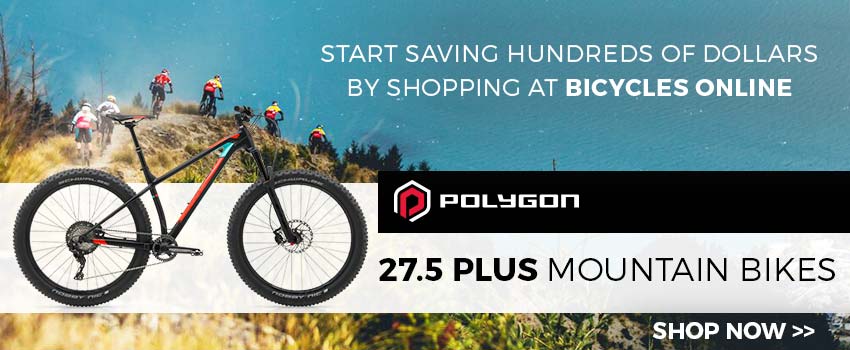Why You Need a 27.5 Plus Mountain Bike?

27.5 Plus Mountain Bikes are the new kid on the block, freshly released onto the market by bike frame designers looking to add another standard and make you spend more money on buying yet another bike. Or is there something about this tyre size that actually makes sense in the real world and gives you real-world advantages?
What is a 27.5 Plus Mountain Bike?
First thing you notice when looking at these bikes is the tyre size, thus the name to define these bikes. But it’s so much more than that.
Tyres:
Yes, they are bigger. By how much?
On a normal mountain bike tyre, current standards say 2.25 inch is the norm (or 57mm). On these new bikes, tyres get as wide as 3.0 inch (77mm), when compared side by side, you can clearly see the difference in width. Not only that, but the actual tyre is taller and the air volume is significantly larger on the Plus bikes. If you now compare it to a standard 29er mountain bike, you can see the tyres are almost the same height/circumference.
What does this all mean? In short, you have extra grip from the extra width, rolls over small bumps as easy as a 29er, and the extra air volume gives you a pneumatic extra suspension on your bike. More on this one further down.

Frame and Geometry:
You would be mistaken if your first thought about these bikes was “this is just a hardtail mountain bike with wider rubber”. The geometry of these bikes and what they are designed to do is completely different from what your old hardtail was designed to do.
Hardtails are historically built for speed, stiffness, power and a riding position that balances performance with some control on steeper descents.
27.5 Plus bikes were designed like a Dual Suspension Trail bike would be. The steerer angle is slacker, the chainstays are shorter and the toptube is longer with a short stem. These bikes were not built to beat land speed records or to compete against hardtails on uphills. These bikes were built for FUN times on the trails riding with your mates and it’s when the trail points down and gets technical that these beasts shine the most.
27.5 Plus Vs. FatBike
The well informed mountain biker will undoubtedly compare the two bikes and most will get to a conclusion like this, “it’s just another fatbike but not as fat for sand and snow riding”. Fortunately, this is not the case, the two types of bike are fairly different.
If you’re not aware of them, FatBikes have enormous tyres, we’re talking about a whooping 4.0 to 5.0 inch wide tyre (100mm to 127mm). These were initially designed to ride on surfaces that until this point were un-rideable, like snow and soft sand dunes. These tyres are technically a 26inch tyre but inflates to be taller than a 29er mountain bike. These bikes float over everything, but due to the special wheel size, the geometry is not exactly trail ready. If you own a FatBike it’s likely because you live in a snowy/sandy area or like travelling to these specialized terrains.
A 27.5 Plus bike will only do marginally better than a standard mountain bike on sand and snow, meaning you will get 10, instead of 5 metres, in and stop.

Tyre pressure:
The so ever important question on mountain bikes these days. If you’re not keeping a close eye on what pressure you’re running your tyres, you might be missing out on grip, performance and/or durability of your tyre.
A Standard 2.25 inch tyre normally runs 30-35 PSI if you use tubes, 20-27 if you go tubeless.
A Plus 3.0 inch tyre can run 15-20 PSI with tubes and 9-15 PSI on a tubeless setup.
This essentially means that the tyre adapts better to the terrain and moulds itself to the surface, greatly improving traction on cornering, climbing and braking. Imagine a wooden chair, when you sit on it you have to adapt to the chair’s shape. Now imagine a bean bag, you sit on it and it adapts itself to your body, involving your body as much as possible. This is what a 27.5 Plus tyre does to the trail you ride over.
On tyre pressures, we must address the pneumatic suspension you get from a less pressured tyre. The 27.5 Plus tyre is arguably taller (height from the rim to the outer circumference of the tyre) than a standard mountain bike tyre. This associated with the reduced air pressure means that when the tyre gets compressed (landing from a jump) the tyre absorbs the energy and bounces back, effectively giving you the sensation of an air suspension system built into the wheels. In one way, this is great because you can ride a hardtail 27.5 Plus bike like you would ride a dual suspension trail bike with 120/140mm travel. However, unlike a dual suspension bike, you cannot manually control the rebound on the suspension and stop it from springing you up once you land from a jump. Knowing the trail and playing with tyre pressure is vital for your bike to work in harmony with the trail and your riding style.
Drawbacks:
There are a few drawbacks to 27.5 Plus bikes:
- Extra Weight on the wheels
- Can’t use wheels, fork or crankset from a non 27.5 Plus bike
- Slower acceleration and extra effort to change direction compared to a standard mountain bike tyre
This will only affect you if you’re looking for a XC racing bike or have multiple wheelsets at home and want to change them for commuting, road riding and mountain biking.
Summary:
You should buy a 27.5 Plus Mountain Bike if you:
- Are a novice rider and like the idea of extra grip when riding off-road. This will give you a confidence boost and help you improve your skills, knowing the bike will help and forgive you when things get hairy.
- Want a fun trail bike but a dual suspension is too much and a hardtail is not comfortable enough.
- Have already a few bikes in your garage and want to dip your toes in a more relaxed, fun-oriented style of mountain biking.
To summarise the 27.5 Plus Mountain Bike in one sentence: This is a super fun trail bike, far more capable of trail riding than a hardtail, making downhills that much more enjoyable for you.
Comments (2)
Drawbacks
23 December 2018I understand that a boost fork/frame can run Plus wheels, but I am not aware of any issues with the crankset. What is the matter? Thanks!
www.bikesonline.com.au Response
Hi Diego, In theory, you can use the same crankset for a "normal" mountain bike on a 27.5 Plus bike but there are Boost cranksets made specifically for 27.5 Plus bikes. The main difference between a non-boost and a boost crankset is the chain-line, that is offset by 3mm on the boost crankset. This centers your chain-line with the cassette and improves shifting and power transfer. Boost cranksets tend to have the same Q-Factor as non-boost cranksets, and both share the same spindle length, 73mm. Hope this helps!
Worth the read!
4 April 2018This is really a worthy and wonderful blog to read and further more tips on mountain bike ideas have been learnt. I’m pretty sure this will be extremely helpful for mtb cycling lovers out there. Thanks for sharing!
 AUS
AUS USA
USA




.jpg)

























